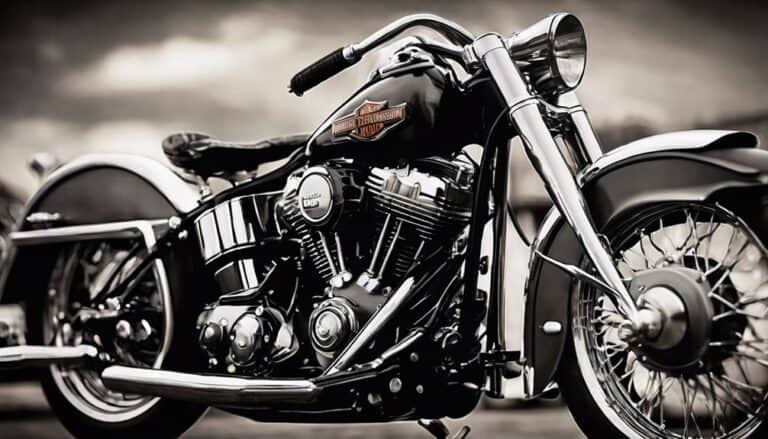If you've ever heard enthusiasts talk about classic Harley-Davidson motorcycles, the mention of the Panhead surely rings a bell.
But what exactly is a Harley Davidson Panhead and why does it hold a special place in the hearts of many riders and collectors alike?
Let's explore the unique characteristics, historical significance, and enduring legacy of this iconic engine that continues to captivate aficionados across the globe.
Key Takeaways
- Panhead engine improved on Knucklehead's flaws
- Featured aluminum heads for better cooling
- Introduced in 1948 with 61 c.i. and 74 c.i. options
- Signified Harley-Davidson's commitment to innovation
Evolution of Harley Panhead Engine
The Harley Panhead Engine underwent a significant transformation in response to the shortcomings of its predecessor, the Knucklehead engine. One notable improvement was the introduction of aluminum cylinder heads, enhancing heat dissipation and overall engine efficiency. These cylinder heads played a crucial role in addressing the overheating issues that plagued the Knucklehead engine, providing a more reliable and durable design. Additionally, the Panhead engine featured redesigned engine covers that not only improved aesthetics but also contributed to better cooling capabilities.
The evolution of the Harley Panhead Engine marked a significant shift towards a more advanced and efficient powertrain. The incorporation of aluminum cylinder heads and redesigned engine covers showcased Harley-Davidson's commitment to innovation and performance. These enhancements not only improved the engine's functionality but also laid the foundation for future advancements in motorcycle engineering. As a rider seeking liberation on the open road, the Panhead engine's evolution represents a pivotal moment in Harley-Davidson's history, setting the stage for enhanced riding experiences and greater reliability.
Key Features of Panhead Motor
In exploring the key features of the Panhead engine, one can appreciate its distinctive design elements and engineering advancements that set it apart in Harley-Davidson's lineup.
The Panhead featured an overhead-valve V-twin design, a significant departure from its predecessor, the Knucklehead. It was available in 61 c.i. (EL) and 74 c.i. (FL, FLH) displacements, offering varying power outputs to cater to different rider preferences.
One of the most iconic features of the Panhead engine was its rocker covers, which bore a striking resemblance to cooking pans, hence the nickname 'Panhead.' These covers not only added to the visual appeal of the engine but also contributed to its cooling efficiency.
Over the years, continual upgrades were made to enhance the Panhead's performance and reliability, making it a sought-after choice for customization and restoration enthusiasts looking to experience the timeless charm of this classic Harley-Davidson engine.
Performance Specifications of Panhead
With its renowned 61 c.i. and 74 c.i. displacements, the performance specifications of the Panhead engine showcase a harmonious blend of power and reliability in Harley-Davidson's iconic lineup. The Panhead engine, introduced in 1948, boasted around 50-55 horsepower, representing a significant leap forward from its predecessor, the Knucklehead engine. This V-twin design featured two cylinders with two valves per cylinder, addressing previous issues and offering enhanced performance and durability. The incorporation of hydraulic lifters in Panhead engines effectively resolved valve lash problems, contributing to smoother operation. Moreover, the transition to hand-operated clutches in Panhead models aimed to enhance the overall riding experience by providing better control and responsiveness. Below is a table highlighting the key performance specifications of the Panhead engine:
| Performance Aspect | Specification |
|---|---|
| Displacement | 61 c.i. and 74 c.i. |
| Horsepower | 50-55 |
| Cylinder Configuration | V-twin |
| Valves per Cylinder | 2 |
| Additional Features | Hydraulic lifters, hand-operated clutches |
Panhead Engine Design History
Introducing a groundbreaking overhead-valve V-twin design in 1948, Harley-Davidson revolutionized motorcycle engineering with the Panhead engine. This innovative engine replaced the older Knucklehead design, offering improved performance and reliability. One of the distinctive features of the Panhead engine was its rocker covers, which resembled inverted cooking pans, giving it the iconic nickname. Available in 61 c.i. (EL) and 74 c.i. (FL, FLH) displacements for various models, the Panhead engine underwent continual upgrades throughout its production run to enhance its overall capabilities.
The transition from the Knucklehead to the Panhead was a significant leap forward for Harley-Davidson, marking a new era in V-twin engine design. The Panhead's overhead-valve configuration provided smoother operation and better efficiency compared to its predecessor. As Harley-Davidson continued to refine the Panhead engine, riders experienced improved power delivery and increased durability, solidifying its reputation as a classic in motorcycle history.
Panhead Vs. Knucklehead: a Comparison
Revolutionizing Harley-Davidson's V-twin lineage in 1948, the Panhead engine set a new standard in performance and reliability compared to its predecessor, the Knucklehead. The distinctive rocker covers resembling cooking pans gave the Panhead its name, distinguishing it visually from the Knucklehead. Available in 61 c.i. (EL) and 74 c.i. (FL, FLH) displacements, the Panhead addressed many of the issues that plagued the Knucklehead era, offering significant improvements in both performance and reliability.
While the Knucklehead paved the way for Harley-Davidson's V-twin engines, the Panhead took this evolution further, cementing its place in motorcycle history. The Knucklehead's valve covers were replaced by the Panhead's iconic pan-shaped covers, which not only enhanced aesthetics but also contributed to better heat dissipation.
Ultimately, the Panhead's advancements in design and performance would later pave the way for the next evolution in Harley-Davidson engines, the Shovelhead.
Conclusion
So there you have it – the Harley-Davidson Panhead, a true legend in the world of motorcycle engines.
With its distinctive design, iconic presence, and rich history, the Panhead has left an indelible mark on motorcycle culture.
Like a shining chrome beacon on the open road, the Panhead continues to capture the hearts of riders and enthusiasts alike, standing as a testament to the enduring legacy of Harley-Davidson.

